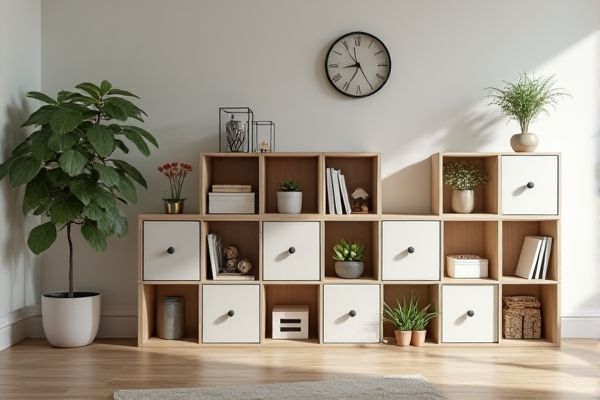
Cube organizers offer uniform compartments ideal for storing similar-sized items, while stepped organizers provide tiered levels that enhance visibility and accessibility for various item sizes. Explore the rest of the article to determine which organizer best suits Your space and storage needs.
Table of Comparison
| Feature | Cube Organizer | Stepped Organizer |
|---|---|---|
| Structure | 3D cube shape with multiple compartments | Tiered, step-like shelves or compartments |
| Storage Capacity | Compact but optimized for small items | Vertical space maximization for various item sizes |
| Accessibility | Easy access from all cube sides | Items visible on each step, easy to reach |
| Ideal Use | Organizing small tools, stationery, or art supplies | Display and organize books, plants, or larger items |
| Material Options | Plastic, wood, or metal cubes | Wood, metal, or acrylic stepped shelves |
| Space Efficiency | Fits compact spaces, modular and stackable | Optimizes vertical wall or desk space |
| Design Style | Modern, geometric look | Open, layered aesthetic |
Introduction: Comparing Cube and Stepped Organizers
Cube organizers provide a compact, grid-like storage solution ideal for categorizing small to medium-sized items with easy visual access, maximizing space efficiency in closets or on shelves. In contrast, stepped organizers feature tiered shelves that elevate items progressively, enhancing visibility and accessibility for frequently used objects like cosmetics, spices, or office supplies. Choosing between cube and stepped organizers depends on the need for either uniform compartmentalization or tiered display to optimize organization and usability.
Design and Aesthetic Differences
Cube organizers feature a uniform, modular grid design that offers a minimalist and modern aesthetic, ideal for showcasing symmetrical storage and clean lines. Stepped organizers present a tiered structure with varying heights, creating visual interest and enhanced accessibility for displayed items. The cubic form emphasizes geometric precision, while the stepped design balances functionality with dynamic, layered visual appeal.
Space Utilization and Room Fit
Cube organizers maximize vertical space with evenly sized compartments, ideal for storing books, bins, and decor in compact rooms. Stepped organizers offer tiered shelving, enhancing visibility and accessibility for items, making them suitable for narrow or corner spaces. Both designs optimize room fit, with cube units providing uniform storage and stepped units adapting to varied item heights and spatial constraints.
Storage Capacity and Flexibility
A cube organizer offers ample storage capacity with large, uniform compartments suitable for bulky items, while a stepped organizer provides tiered shelves enhancing visibility and access for smaller or frequently used items. The stepped design allows greater flexibility in organizing by accommodating varied item sizes and creating easy-to-reach storage zones. Your choice depends on whether you prioritize maximizing volume or optimizing accessibility and organization versatility.
Versatility in Home Decor
Cube organizers offer versatile storage solutions with customizable compartments that adapt to various home decor styles, making them ideal for displaying books, plants, and decorative items. Stepped organizers provide tiered shelving that enhances visual interest and maximizes vertical space, perfect for showcasing collectibles or framed photos in a compact area. Your choice depends on whether you prioritize modular flexibility or aesthetic layering to complement your living space.
Ease of Assembly and Installation
Cube organizers offer straightforward assembly with modular components that snap or lock into place, making the process quick and manageable for most users. Stepped organizers often require more precise alignment and securing, involving additional steps like screwing or anchoring, which can extend installation time. Your choice depends on whether ease and speed or structural design complexity are your priority.
Durability and Material Options
Cube organizers often feature sturdy materials like reinforced wood, metal frames, or heavy-duty plastic, offering enhanced durability suitable for long-term use. Stepped organizers typically use lighter materials such as MDF, plastic, or thin wood panels, which may compromise strength but allow for easier portability. Choosing between the two depends on the intended load capacity and frequency of use, with cube organizers generally providing superior resilience.
Accessibility and Organization
A cube organizer offers easy accessibility with its open-front design, allowing you to quickly retrieve items without removing other contents, ideal for efficiently organizing larger objects or bulkier materials. The stepped organizer provides a tiered layout that enhances visibility and accessibility for smaller items, making it perfect for neatly arranging supplies while reducing clutter in your workspace. Your choice depends on the need for either maximizing storage space or prioritizing quick access to frequently used materials.
Price Comparison and Value
Cube organizers typically offer a more affordable price point due to their simple design, making them ideal for budget-conscious consumers. Stepped organizers, often crafted with premium materials and featuring tiered compartments, tend to be pricier but provide greater accessibility and organization efficiency. The value of a stepped organizer lies in its ability to maximize visibility and quick retrieval, justifying the higher cost for users seeking enhanced functionality.
Best Uses and Recommendations
Cube organizers excel in maximizing vertical storage for office supplies or craft materials, making them ideal for small spaces requiring compact, versatile solutions. Stepped organizers are best suited for showcasing products or organizing items by priority due to their tiered design, providing clear visibility and easy access. For efficient workspace organization, choose cube organizers for varied item sizes and stepped organizers for orderly display and quick retrieval.
 homyna.com
homyna.com